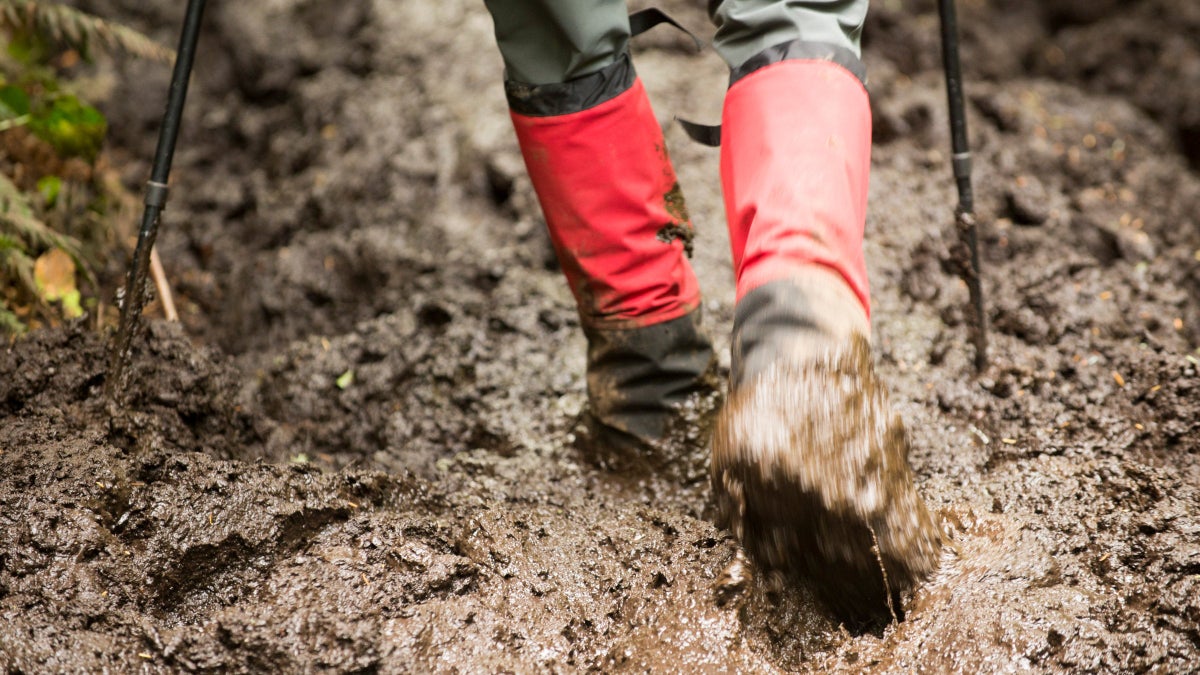
Whenever I encounter mud puddles on a trail, I flash back to one of the best-loved books of my 1990s childhood, We’re Going On A Bear Hunt. After contending with tall grass and a river, the characters in the book find themselves facing their latest obstacle, “thick, oozy mud.” “We can’t go over it, we can’t go under it,” they muse. The solution they land on: go through it. (Spoiler: They find the bear in a cave and run away—not at all hiker protocol.)
As it turns out, that’s good advice on soggy trails: Go straight through the squish and slop. Walking around it causes erosion, compacts soil, tramples vegetation, and unnecessarily widens the path.
Because mud is a possibility on any given trail, even on the clearest and driest of days, it’s best to embrace it and know ahead of time what to do when you find yourself in front of a seemingly impassable mud swamp. We asked folks at the Appalachian Mountain Club (AMC) and the Green Mountain Club (GMC), which both oversee trails that can get quite muddy, to share their best advice for getting through mud season and dealing with mud in general.
- Assess conditions before you go
As with any hike, check the weather and trail conditions ahead of time so you know what you’re getting yourself into. Peruse hiking apps and blogs for recent reviews from hikers who might mention mud. Local hiking organizations also do their best to post trail reports. Some recreation areas, like in Vermont, will even close trails during muddy conditions to reduce hazards and protect the trails.
Spring is the season you’re most likely to encounter mud, says Emily Davenport, a guided outdoors program manager at AMC. When possible, she hikes on dry days, avoids trekking through lowland and wetland areas, and opts for south-facing and rocky trails that tend to be drier during the wetter months. She’ll also skip trails with too many stream crossings, which swell with melting snow in the springtime. “Even smaller streams in the summertime might be more consequential in the spring,” she says.
- Stay on sturdy surfaces when available
To help hikers navigate the muck, proactive trail maintenance crews strategically place rocks, logs, and planks of wood—which are called “bog bridges” in the White Mountains, Davenport says. These landing pads can make it easier as well as cleaner to cross the muddy sections.
You’ll find these mud diversions especially in the northeast, where many of the historic trails were built straight up the mountain without switchbacks. That means snowmelt runs straight down them, creating muddy messes.
- Build in extra time to go slow
Carefully picking your way through mud crossings can slow you down. Davenport suggests factoring in that the hike might take a little bit longer when it’s slick than when it’s dry. “Take your time and go a little bit more slowly,” she says. There’s nothing worse than feeling the pressure to rush and falling on your bum into a mud puddle.
- Pack and wear the right gear
Footwear is the first piece of gear to consider for a muddy hike. Some hikers designate a pair as their mud shoes. Others prefer light hikers that aren’t waterproof but can drain water when submerged. Both Davenport and Emily Mosher at the GMC said they prefer waterproof boots for the protection and stability. Pair them with gaiters to keep out even more debris, and pack an extra pair of socks just in case you end up accidentally submerging your feet.
“As long as my feet are dry and warm, I’m okay,” Davenport says.
Traction devices and trekking poles can also be useful, Mosher adds. Mud often signals ice and snow higher up, so ice cleats or other traction can come in handy. And trekking poles can add stability and act as a measuring stick to see how deep the water and mud goes. “I’ve used them to find rocks in the trail so I don’t sink down into a muddy section of trail,” Mosher says.
- Have a cleanup plan
Whether you hose off your boots right away or let the mud dry first is up to you. But coming up with a clean-up system will help you manage your muddy gear. If there’s not a spigot available, Mosher recommends shaking off as much mud as you can at the trailhead, then removing the rest with a dry brush after it has dried.
For the drive home, keep muddy things contained in a tub or bag in the back of your car. “Something I always recommend is having an extra pair of shoes and socks to leave in your car so you don’t have to drive home in muddy boots,” Mosher says.
- Don’t let the dry weather fool you
Just because the ground is dry at the trailhead doesn’t mean it’s dry the whole way, especially in areas that experience snow melt. It might start out dusty, but quickly turn into mud and then snow. “I’ve been on some hikes mid-May where down in the valley it’s beautiful and then higher up we’re postholing in waist-deep snow,” Davenport says.
Mud season is a good reminder to not get too comfortable with the weather and to stay prepared for any conditions. And as always, “If a trail gets to be too muddy or out of your experience range, it’s okay to turn around,” Mosher adds.
The post Mud Season Is Coming. Are You Ready to Survive It? appeared first on Outside Online.















